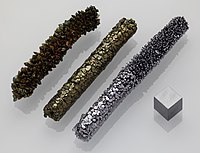
Photo from wikipedia
Abstract The complexation properties of aqueous vanadate with diethanolamine (DEA) and iminodiacetate (IDA) derivatives were elucidated by NMR spectroscopy and DFT calculations. The coordination geometries of vanadium in 1:1 complexes… Click to show full abstract
Abstract The complexation properties of aqueous vanadate with diethanolamine (DEA) and iminodiacetate (IDA) derivatives were elucidated by NMR spectroscopy and DFT calculations. The coordination geometries of vanadium in 1:1 complexes of the DEA derivatives were confirmed to be trigonal–bipyramidal with a tridentate binding mode. The trigonal–bipyramidal complexes of N,N-bis(2-hydroxyethyl)glycinate (Bicine) and N-(2-hydroxyethyl)iminodiacetate (HIDA) binding through the nitrogen atom, hydroxyethyl and carboxymethyl groups, were also formed at lower and higher pHs, respectively. Vanadate binds with IDA through the nitrogen atom and one of two carboxymethyl groups to form a trigonal–bipyramidal complex, in addition to the trigonal–bipyramidal complex binding through the nitrogen atom and both of the carboxymethyl groups. The latter five-coordinate complex has an open space suitable for additional coordination at the apical position of the central vanadium, which is the same side of the hydrogen atom on the coordinating nitrogen. When an appropriate functional group, such as a carboxymethyl group, acetamido group or hydroxyethyl group, exists instead of the hydrogen atom on the nitrogen, these groups can coordinate to the central vanadium to form a highly stable octahedral complex with a tetradentate binding mode. These findings made it possible to provide an integrated and comprehensive interpretation about the complexation properties of the aqueous vanadate.
Journal Title: Polyhedron
Year Published: 2017
Link to full text (if available)
Share on Social Media: Sign Up to like & get
recommendations!